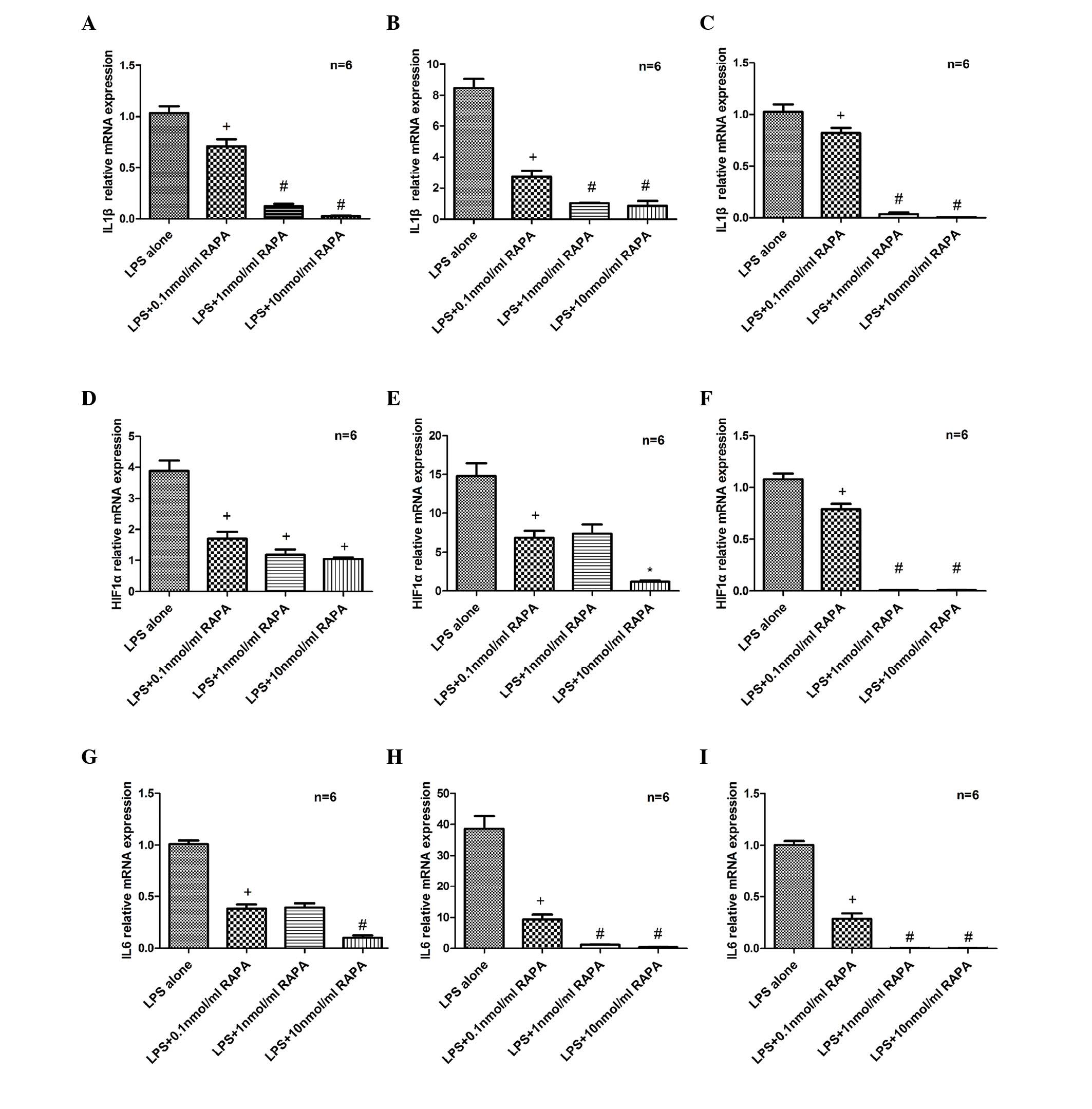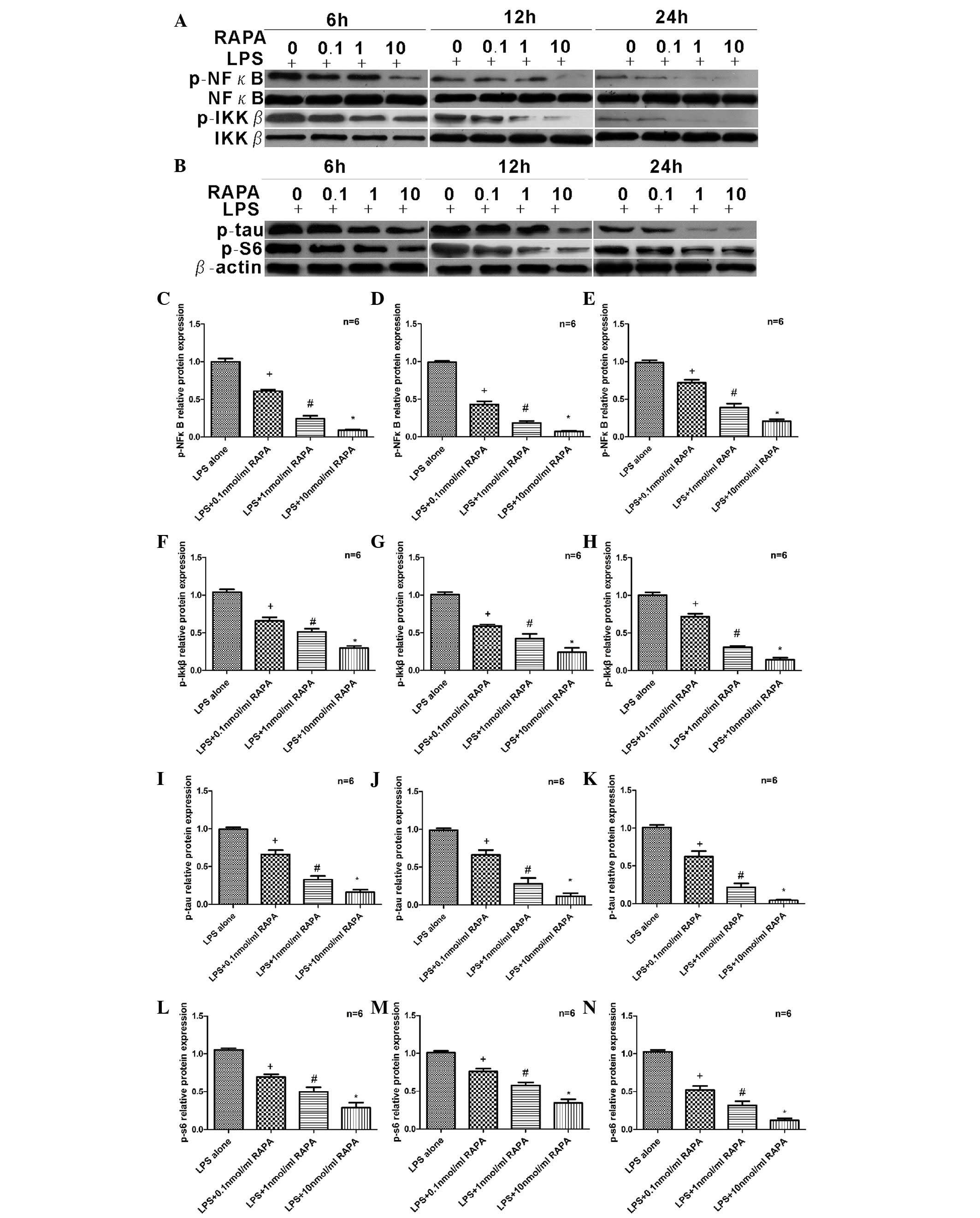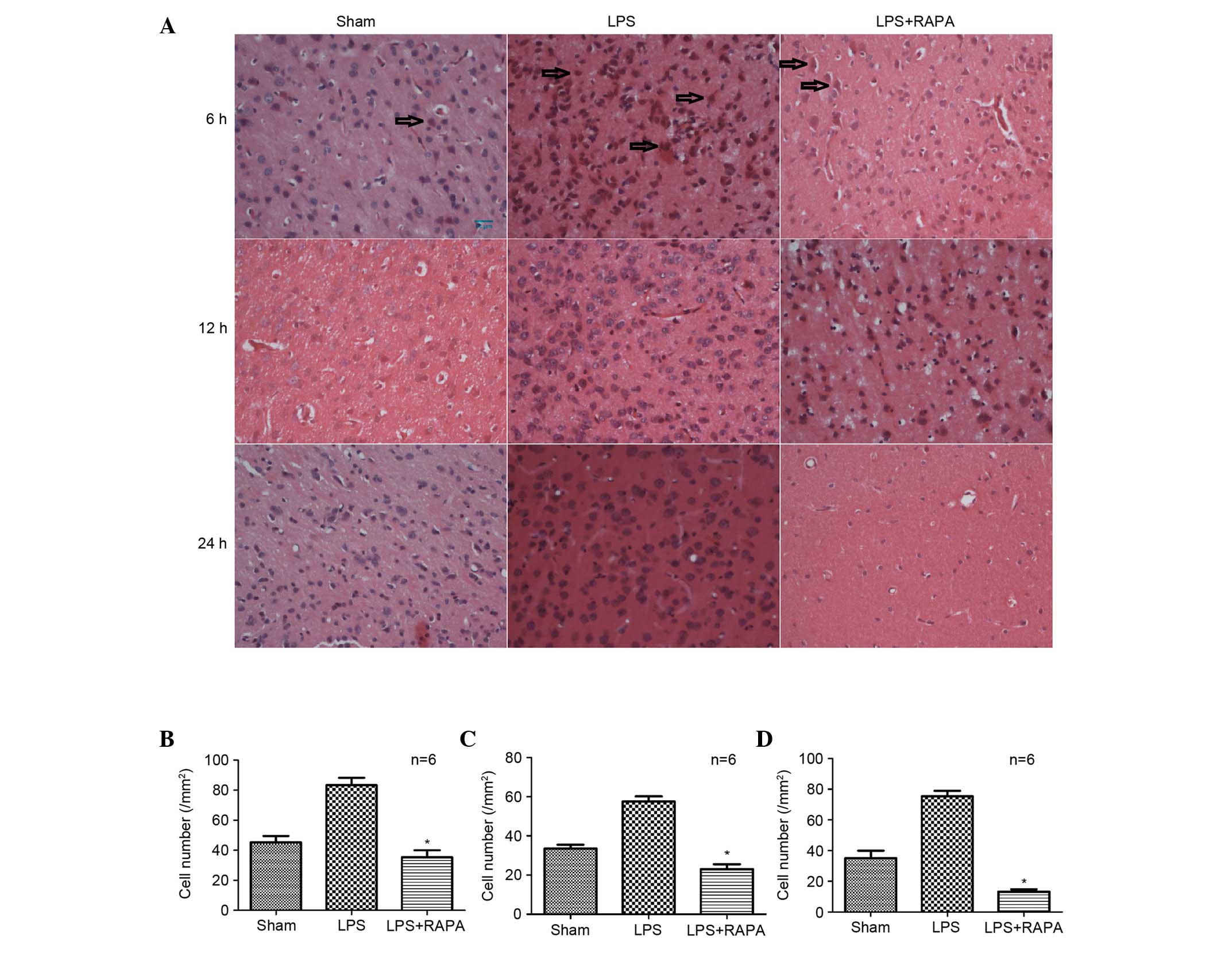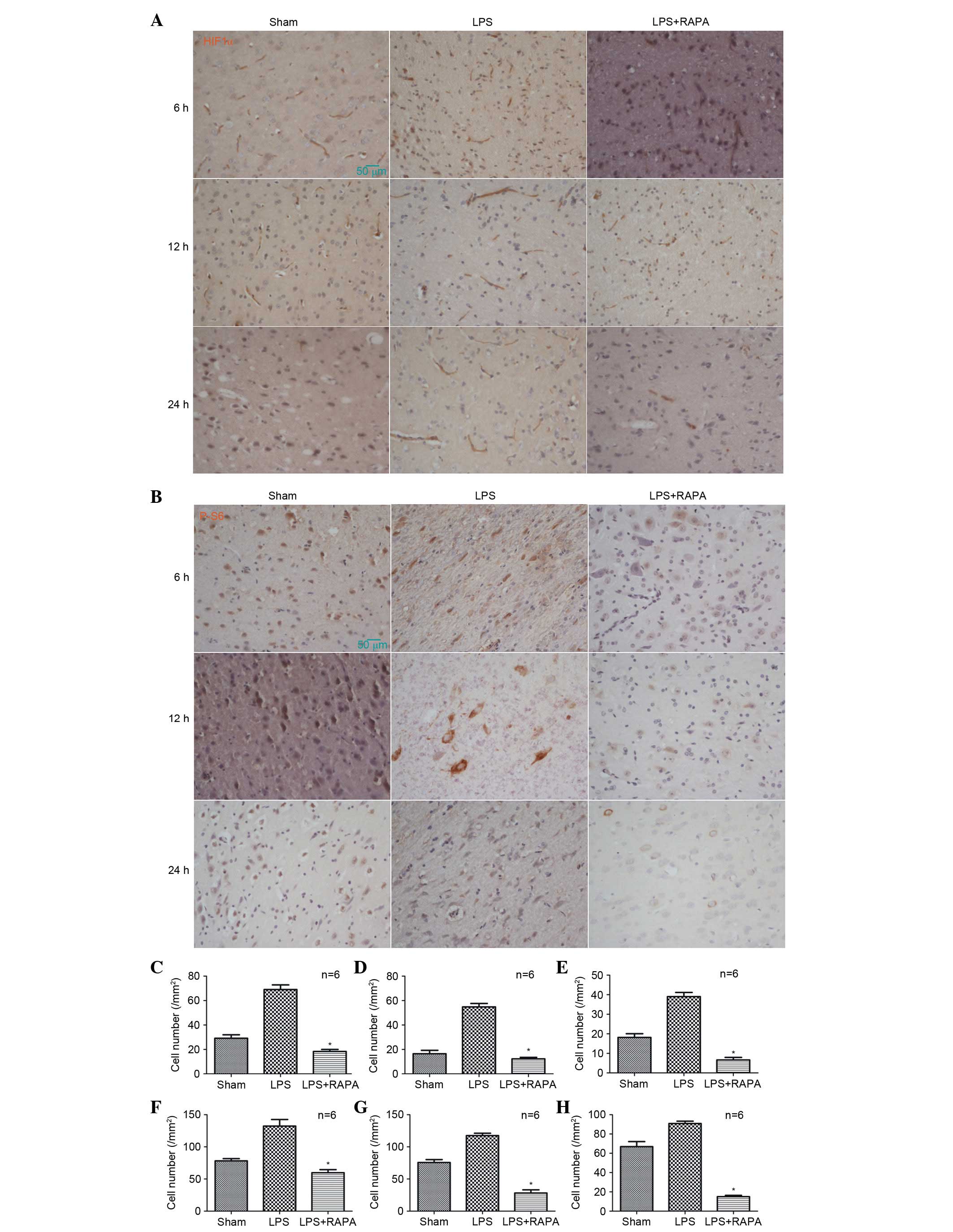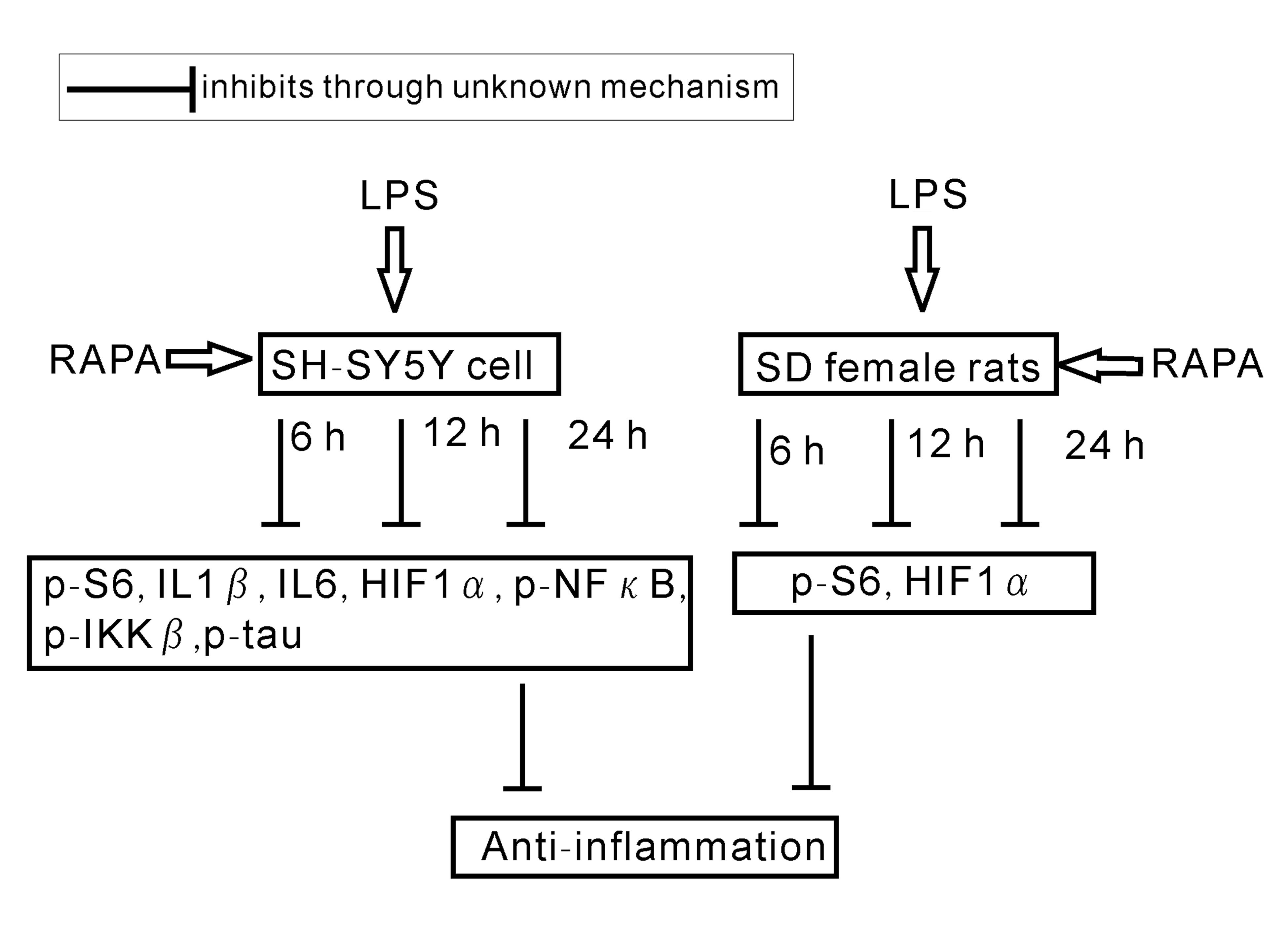Rapamycin inhibits lipopolysaccharide-induced neuroinflammation in vitro and in vivo
- Authors:
- Published online on: October 25, 2016 https://doi.org/10.3892/mmr.2016.5883
- Pages: 4957-4966
-
Copyright: © Mengke et al. This is an open access article distributed under the terms of Creative Commons Attribution License.
Abstract
Introduction
Alzheimer's disease (AD) is characterized clinically by progressive memory loss and cognitive decline (1). In the United States, ~5 million people have AD and with an aging population, ~16 million people are predicted to be diagnosed with AD by middle of the century in the US alone (2). Neuropathological features of AD include extracellular aggregation of amyloid-β (Aβ) and intraneuronal neurofibrillary tangles (aggregates of tau composed primarily of hyperphosphorylated tau) (3). In addition, inflammation occurs in the brains of patients with AD. In primary microglial and astrocyte cell cultures obtained from postmortem AD patients and nondemented elderly (ND) controls, and in neuroblastoma cell lines, the plaque-associated cytokines interleukin (IL) 1β, IL6 and hypoxia-inducible factor 1α (HIF1α) stimulated the production of complement component (C) 1 s and C1r as a result of direct binding and activation of C1 by Aβ (4). Furthermore, patients with no history of dementia who exhibit sufficient limbic Aβ deposits and neurofibrillary tangles at autopsy to qualify for a diagnosis of AD, reveal levels of inflammatory markers that are significantly greater than in typical ND controls but markedly reduced compared with AD patients.
The mammalian target of rapamycin (mTOR) is a phosphatidylinositol kinase-related serine-threonine kinase (5) that modulates the activity of ribosomal S6, nuclear factor κB (NFκB) and inhibitor of NFκB kinase subunit β (IKKβ) via phosphorylation. As a consequence, mTOR initiates translation and affects cell growth and proliferation. Rapamycin (RAPA) is a macrolide antibiotic that was initially developed as an antifungal agent, which has potent immunosuppressive and antiproliferative properties (5), and is currently used to prevent rejection in organ transplantation, particularly lung and kidney (6). Lipopolysaccharide (LPS), which is a component of the outer membrane of Gram-negative bacteria, activates glial cells, inducing inflammation in the periphery and in the central nervous system (CNS) (7). A local injection of LPS has been demonstrated to induce inflammation in numerous tissue types (8,9).
The present study examined the effects of RAPA on the LPS-stimulated inflammatory response in SH-SY5Y human neuroblastoma cells. In addition, the effects of RAPA treatment, acting via mTOR signaling pathways on traumatic brain injury recovery in a rat model of neuroinflammation, were investigated.
Materials and methods
RAPA preparation
RAPA (Sigma-Aldrich, St. Louis, MO, USA) was dissolved in deionized water (10 mg/ml) and stored at −20°C. For in vivo experiments, this stock solutionwas diluted to 1 mg/ml immediately prior to intragastric administration. Rats in the treatment group received RAPA (1 mg/kg) and control animals received normal saline (NS), 30 min prior to surgery (10).
Cell culture and drug treatment
SH-SY5Y human neuroblastoma cells were obtained from the Cell Bank of the Chinese Academy of Sciences (Shanghai, China). The cells were cultured at 37°C in a humidified incubator containing 5% CO2 in Dulbecco's modified Eagle's medium (DMEM; Gibco; Thermo Fisher Scientific, Inc., Waltham, MA, USA) supplemented with 15% fetal bovine serum (FBS; Gibco; Thermo Fisher Scientific, Inc.) and 2 mM L-glutamine. The cells were maintained in the logarithmic phase of growth and subcultured every 3–4 days. Prior to experimentation, the medium was removed and replaced with 0.01% trypsin-ethylenediaminetetraacetic acid (EDTA) (Gibco; Thermo Fisher Scientific, Inc.), which had been warmed to 37°C. The cell layer was completely covered and incubated at 37°C for ~3 min to allow detachment of the cells. Subsequently, complete medium (containing 0.02–0.03% trypsin) was added and the cell suspension was transferred to a clean tube. The cells were centrifuged at 200 × g for 5 min at room temperature, the supernatant was discarded and the cells were resuspended in fresh medium. Experiments were performed 24 h later. The medium was removed and replaced with medium supplemented with FBS containing LPS (20 µg/ml) or LPS (20 µg/ml) and RAPA (0.1, 1.0 or 10 nmol/ml). Cells were incubated for 6, 12 or 24 h, and were subsequently digested with trypsin for reverse transcription-quantitative polymerase chain reaction (RT-qPCR) and western blot analysis.
RT-qPCR
Total RNA samples were isolated from SH-SY5Y cells using TRIzol® reagent (Invitrogen; Thermo Fisher Scientific, Inc.) according to the manufacturer's protocol. The total RNA products (1 µg) were immediately transcribed into cDNA using a PrimeScript™RT Reagent kit with Genomic DNA Eraser (Takara Biotechnology Co., Ltd.). qPCR was performed on a Chromo4 Four-Color Real-Time PCR Detection system (Bio-Rad Laboratories, Inc., Hercules, CA, USA) using the SYBR® Premix Ex Taq™II (Tli RNaseH Plus) kit (Takara Biotechnology Co., Ltd.). Cycling conditions were as follows: Initial denaturation at 95°C for 30 sec, followed by 40 cycles of 95°C for 5 sec, 60°C for 20 sec and 72°C for 15 sec. Data was normalized using the 2−ΔΔCq method (11). Primers were synthesized by Thermo Fisher Scientific, Inc. (Table I).
Western blot analysis
Cells were trypsinized, washed twice with ice-cold phosphate-buffered saline, lysed in radioimmunoprecipitation assay buffer (20 mmol/l Tris-HCl, 150 mmol/l NaCl, 1 mmol/l EDTA, 1% NP-40, 1 mmol/l Na3VO4, 1 mmol/l phenylmethylsulfonyl fluoride, 5 µg/ml leupetin, 5 µg/ml aprotinin and 5 µg/ml chymostatin; pH 7.4) and were centrifuged at 3,000 × g for 5 min at room temperature. Lysates were clarified and the protein concentrations were determined according to the method of Lowry et al (12), using bovine serum albumin (Gibco; Thermo Fisher Scientific, Inc.) as the standard. Cellular proteins (20 µg) were separated by 10% sodium dodecyl sulfate-polyacrylamide gel electrophoresis and were transferred to polyvinylidene difluoride membranes (EMD Millipore, Billerica, MA, USA). Membranes were blocked with 5% non-fat milk in Tris-buffered saline (TBS) containing 0.05% Tween-20 (TBST) for 2 h at room temperature. Subsequently, membranes were probed with the following primary antibodies, diluted 1:1,000, overnight at 4°C: rabbit anti-NF-κB (catalog no. 8242), rabbit anti-phosphorylated (p)-NF-κB (catalog no. 3033), rabbit anti-IKKβ (catalog no. 8943), rabbit anti-p-IKKβ (catalog no. 2694), rabbit anti-p-tau (catalog no. 15013), rabbit anti-p-S6 (catalog no. 4858) and rabbit anti-β-actin (catalog no. 8457), purchased from Cell Signaling Technology, Inc., (Danvers, MA, USA). The membranes were then washed three times for 7 min with TBST and incubated with an anti-rabbit IgG conjugated to horseradish peroxidase (1:5,000; catalog no. 7074; Cell Signaling Technology, Inc.) for 1 h at room temperature. Protein bands were visualized using SignalFire™ Elite Enhanced Chemiluminescence reagent (Cell Signaling Technology, Inc.). The results were normalized to β-actin using Image J software version 1.48 (National Institutes of Health, Bethesda, MD, USA).
Animals and drug treatment
Ethical approval was provided by the Medical Ethics Committee of Southern Medical University (Guangzhou, China). Female Sprague Dawley (SD) rats (n=18; age, 6 weeks; weight, 170–180 g), were purchased from Southern Medical University. Rats were maintained at a constant humidity and temperature under a 12-h light/dark cycle with ad libitum access to food and water. The rats were randomly assigned to sham, LPS and LPS+RAPA groups (n=6/group). In the LPS + RAPA group, RAPA (1 mg/kg) was administered by gavage 30 min prior to surgery. Neuroinflammation was induced as described by Espinosa-Oliva et al (13). Rats were anesthetized with an intraperitoneal injection of 250 mg/kg ketamine (Zoetis, Inc., Florham Park, NJ, USA). Sterile techniques were used and the left lateral ventricle was reached by stereotaxic surgery. With the incisor bar placed 3.3 mm below the interaural line (horizontal zero), the coordinates with respect to bregma for the guide cannula were 1.0 mm anteroposterior, 1.5 mm lateral and 3.8 mm dorsoventral. LPS (100 µg/kg) was then injected intracranially in the LPS and LPS+RAPA groups. The sham group underwent surgery but received no treatment.
Immunohistochemistry
Rats were anesthetized using 250 mg/kg ketamine and 2% xylazine (10 mg/kg, Sigma-Aldrich) for a duration of 6, 12 or 24 h following surgery, and were subsequently sacrificed by rapid decapitation. The collected brain tissues were fixed in 4% paraformaldehyde in 0.1 M phosphate buffer (pH 7.4) for 8 h at 0°C. Fixed brains were paraffin embedded and cut into 2 µm sections using a microtome (Leica Microsystems GmbH, Wetzlar, Germany). Sections were briefly washed with TBS and incubated for 30 min in 3% H2O2 to quench endogenous peroxidase activity. The following primary antibodies: Rabbit anti-HIF1α (1:100; catalog no. sc-10790; Santa Cruz Biotechnology, Inc., Dallas; Texas; U.S.A) and rabbit anti-p-S6 (1:100; catalog no. 4858; Cell Signaling Technology, Inc.) were applied overnight at 4°C. Subsequently, sections were washed three times with TBS and then incubated with SignalStain® Boost Immunohistochemistry Detection reagent (1:50; catalog no. 8114; Cell Signaling Technology, Inc.) for 1 h at room temperature. Sections were then incubated with 3,3′-diaminobenzidine (ZSGB-BIO, Beijing, China). Finally, the sections were dehydrated, mounted and examined under a light microscope (Leica Microsystems GmbH). Positive cells were counted using Image-Pro Plus software verison 7.0 (Media Cybernetics, Inc., Rockville, MD, USA).
Histological assays
Paraffin sections were stained with hematoxylin and eosin (H&E) according to the manufacturer's protocol. The cells which were swollen or were abnormally circular cells were defined as positive cells, and these cells were counted using Image-Pro Plus software verison 7.0.
Statistical analysis
Data are representative of a minimum of three independent experiments, each of which were performed in triplicate. Statistical analyses were conducted using GraphPad Prism software, version 3.0 (GraphPad Software, Inc., La Jolla, CA, USA). Data were analyzed using a one-way analysis of variance followed by Tukey's post hoc test. Data are expressed as the mean ± standard error. P<0.05 was considered to indicate a statistically significant difference.
Results
RAPA attenuates LPS-induced increases in IL1β, HIF1α and IL6 mRNA expression levels
SH-SY5Y cells were cultured with 20 µg/ml LPS and 0.1–10 nmol/ml RAPA for 6, 12 or 24 h. RT-qPCR revealed that IL1β mRNA expression was significantly reduced following treatment with RAPA compared with the LPS only group, at 6 (P=0.029; Fig. 1A), 12 (P=0.0011; Fig. 1B) and 24 h (P=0.003; Fig. 1C). In addition, HIF1α (P=0.0229 at 6 h, P=0.0005 at 12 h and P=0.0001 at 24 h vs. LPS alone; Fig. 1D-F) and IL6 (P=0.015 at 6 h, P=0.005 at 12 h and P=0.0001 at 24 h vs. LPS alone; Fig. 1G-I) mRNA expression levels were significantly reduced in the RAPA groups compared with the LPS only group.
RAPA attenuate LPS-induced increases in p-S6, p-tau, p-NFκB and p-IKKB
SH-SY5Y cells were treated with 20 µg/ml LPS and 0.1–10.0 nmol/ml RAPA for 6, 12 or 24 h. Western blot analysis (Fig. 2A and B) revealed that expression levels of p-NFκB decreased gradually with increasing concentrations of RAPA at 6 (P=0.0025; Fig. 2C), 12 (P=0.0011; Fig. 2D) and 24 h (P=0.0014; Fig. 2E). A similar pattern was observed for p-IKKβ (P=0.0125 at 6 h, P=0.0115 at 12 h and P=0.001 at 24 h vs. LPS alone; Fig. 2F-H), p-tau (P=0.019 at 6 h, P=0.025 at 12 h and P=0.003 at 24 h vs. LPS alone; Fig. 2I-K) and p-S6 (P=0.005 at 6 h, P=0.001 at 12 h and P=0.0005 at 24 h vs. LPS alone; Fig. 2L-N). At 6 h, suppression of p-NFκB (Fig. 2C), p-IKKβ (Fig. 2F) and p-S6 (Fig. 2L) began and appeared to be dose-dependent. In addition, the inhibitory effect on p-NFκB lasted for 12 h (Fig. 2D), and even 24 h (Fig. 2E). Similarly, expression of p-IKKβ was decreased at 12 (Fig. 2G) and 24 h (Fig. 2H). Therefore, critical components of the NFκB signaling pathway, p-NFκB and p-IKKβ, were suppressed by RAPA and the neuroinflammation protein, p-tau was decreased. In addition, the downstream protein of the mTOR signaling pathway, p-S6 was downregulated by RAPA.
RAPA increases the anti-inflammatory properties of neurons
Female SD rats were randomly divided into sham, LPS and LPS + RAPA groups. Cerebral cortex sections stained with H&E revealed that treatment with LPS caused cells to become swollen and abnormally circular, in a time-dependent manner (P=0.029 at 6 h, P=0.018 at 12 h and P=0.003 at 24 h vs. sham; Fig. 3A-D); this damage was abrogated by RAPA (P=0.009 at 6 h, P=0.001 at 12 h and P=0.0002 at 24 h vs. LPS; Fig. 3A-D). The swollen and abnormally circular cells within sections were counted to quantify the LPS-induced inflammation. The inflammatory response in the neurons increased in the LPS group; however, this increase was reduced over time in the LPS + RAPA group [6 (Fig. 3B), 12 (Fig. 3C) and 24 h (Fig. 3D)]. Detection of HIF1α (Fig. 4A) and p-S6 (Fig. 4B) by immunohistochemistry determined that expression levels of HIF1α in rat cerebral cortex increased following LPS injection (P=0.0021 at 6 h, P=0.0011 at 12 h and P=0.00022 at 24 h vs. sham; Fig. 4C-E); however, this increase was abrogated over time by RAPA treatment, at 6 (P=0.001 vs. LPS; Fig. 4C), 12 (P=0.005 vs. LPS; Fig. 4D) and 24 h (P=0.003 vs. LPS; Fig. 4E). A similar pattern was observed for p-S6 expression levels, with increased levels following LPS injection (P=0.021 at 6 h, P=0.011 at 12 h and P=0.013 at 24 h vs. sham), abrogated by RAPA treatment (P=0.0029 at 6 h, P=0.0021 at 12 h and P=0.0022 at 24 h vs. LPS; Fig. 4F-H).
Discussion
The present study demonstrated that, following an LPS-induced neuroinflammatory response, RAPA significantly altered the expression of key proteins and cytokines, and modulated the neuronal inflammatory response. It has previously been demonstrated that RAPA inhibits the mTOR complex 1 (mTORC1) signaling pathway and prevents phosphorylation of proteins involved in transcription, translation and cell cycle control (14).
Although inflammation has long been implicated in AD pathogenesis, its importance has recently become more widely recognized. Increasing evidence has suggested that inflammation is critical for the initiation and progression of AD; it has therefore been identified as a potential therapeutic target. AD has been associated with polymorphisms in genes involved in inflammation (15). IL1 is an immunoregulatory cytokine that has been shown to be overexpressed in affected regions of the cerebral cortex in patients with AD, as determined by quantitative assays of tissue IL1 concentrations and analysis of IL1-immunoreactive microglia (16,17). IL6 is a pleiotropic cytokine that mediates inflammation affecting the growth and differentiation of cells in the CNS (18,19). Although IL6 is widely accepted to be involved in various CNS disorders, there is evidence to suggest that, in certain circumstances, IL6 may have anti-inflammatory effects as well as other beneficial properties. For example, IL6 has been demonstrated to be critical in the regulation of neuronal survival and function (20–24). In the present study, RT-qPCR analyses revealed that IL1β and IL6 mRNA expression levels were significantly suppressed by RAPA treatment. These anti-neuroinflammatory effects may provide neuroprotection.
HIF1α, which is the functional subunit of HIF1, is typically activated under conditions of hypoxia (25,26). HIF-1 has been demonstrated to be an essential transcription factor that mediates oxygen homeostasis and exhibits an adaptive response to the pathological conditions that result from hypoxia (27), upregulating genes that protect against cerebrovascular diseases and neurodegenerative disorders (28). A previous study suggested that HIF1α may be a novel therapeutic target for the treatment of cerebral ischemia (29). When inflammation occurs under conditions of hypoxia, an increase in the mRNA expression levels of HIF1α and the activation of mTOR have been observed (30,31). Using RT-qPCR and immunohistochemistry, the present study demonstrated that in the presence of RAPA, the HIF1α levels were markedly decreased in vivo and in vitro from 6 to 24 h. This may downregulate the expression of genes responsible for protection against cerebral inflammatory injury, and thus provide neuroprotection. Certain previous studies have demonstrated that myeloid-specific deletion of HIF-1α impaired inflammatory responses, which was associated with a metabolic defect characterized by lower glycolytic rates and energy generation in the absence of HIF-1α (32,33).
mTOR integrates signaling pathways that respond to growth factors, energy metabolism, nutrients and in addition, stress (34). Postmortem evidence from the brains of patients with AD indicated that expression levels of p-S6 are increased compared with brains from age-matched controls, thus suggesting that mTORC1 activity is elevated in AD brains (35–41) and that events downstream of mTORC1 are involved in AD (42). The increase in mTOR-dependent signaling has also been positively and significantly correlated with total tau and p-tau expression levels, and the decades-long continuous synthesis of tau in degenerating neurons resulted from upregulated mTOR-dependent signaling (40). Evidence has indicated a direct association between the neuropathological effects of Aβ and activation of the NFκB signaling cascade (43). Aβ induces the accumulation of inhibitor of κB, a downstream transcriptional target of the NFκB signaling pathway. The results of the present study revealed that RAPA inhibited the expression of the mTORC1 downstream target, p-S6, and the NFκB downstream targets, p-NFκB and p-IKKβ, in addition to suppressing p-tau protein expression levels. This is indicative of anti-neurodegenerative effects mediated by RAPA via mTORC1 and the downstream NFκB signaling pathway (Fig. 5).
Activated microglia produce cytotoxic molecules, including nitric oxide, oxygen radicals, arachidonic acid derivatives and in addition, cytokines (1,15,44–46). Numerous mechanisms may underlie the contribution of post-traumatic inflammation to neuronal damage (10); the anti-inflammatory effects of early RAPA treatment may reduce microglial activation and enhance recovery from head trauma. RAPA is non-cytotoxic in vivo and may be used as an anti-angiogenic agent to inhibit tumor growth (6). The lack of toxicity of RAPA adds weight to the importance of the neuroprotective effects of RAPA revealed in the present study.
In conclusion, the results of the present study demonstrated that RAPA suppresses the neuroinflammation induced by LPS, in vitro and in vivo. RAPA may therefore be a potential therapeutic agent for the treatment of early AD, or for the treatment of neuroinflammation in non-AD patients to prevent the onset of AD. However, further studies are required to confirm the suitability of RAPA as a treatment strategy.
Acknowledgements
The authors would like to thank Mr. Sheng-fa Li (Huzihou First Hospital, Huizhou, China) and Mr. Wen-ji Zhao (Inner Mongolia People's Hospital, Hohhot, China) for providing reagents, instructive suggestions and valuable comments.
References
|
Giulian D: Microglia and the immune pathology of Alzheimer disease. Am J Hum Genet. 65:13–18. 1999. View Article : Google Scholar : PubMed/NCBI | |
|
Alzheimer's Association: 2014 Alzheimer's disease facts and figures. Alzheimers Dement. 10:e47–e92. 2014. View Article : Google Scholar : PubMed/NCBI | |
|
Golde TE, Petrucelli L and Lewis J: Targeting Abeta and tau in Alzheimer's disease, an early interim report. Exp Neurol. 223:252–266. 2010. View Article : Google Scholar : PubMed/NCBI | |
|
Veerhuis R, Janssen I, De Groot CJ, Van Muiswinkel FL, Hack CE and Eikelenboom P: Cytokines associated with amyloid plaques in Alzheimer's disease brain stimulate human glial and neuronal cell cultures to secrete early complement proteins, but not C1-inhibitor. Exp Neurol. 160:289–299. 1999. View Article : Google Scholar : PubMed/NCBI | |
|
Baker H, Sidorowicz A, Sehgal SN and Vézina C: Rapamycin (AY-22,989), a new antifungal antibiotic. III. In vitro and in vivo evaluation. J Antibiot (Tokyo). 31:539–545. 1978. View Article : Google Scholar : PubMed/NCBI | |
|
Majumder PK, Febbo PG, Bikoff R, Berger R, Xue Q, McMahon LM, Manola J, Brugarolas J, McDonnell TJ, Golub TR, et al: mTOR inhibition reverses Akt-dependent prostate intraepithelial neoplasia through regulation of apoptotic and HIF-1-dependent pathways. Nat Med. 10:594–601. 2004. View Article : Google Scholar : PubMed/NCBI | |
|
Bonow RH, Aïd S, Zhang Y, Becker KG and Bosetti F: The brain expression of genes involved in inflammatory response, the ribosome, and learning and memory is altered by centrally injected lipopolysaccharide in mice. Pharmacogenomics J. 9:116–126. 2009. View Article : Google Scholar : PubMed/NCBI | |
|
Hauss-Wegrzyniak B, Lukovic L, Bigaud M and Stoeckel ME: Brain inflammatory response induced by intracerebroventricular infusion of lipopolysaccharide: An immunohistochemical study. Brain Res. 794:211–224. 1998. View Article : Google Scholar : PubMed/NCBI | |
|
Burguillos MA, Hajji N, Englund E, Persson A, Cenci AM, Machado A, Cano J, Joseph B and Venero JL: Apoptosis-inducing factor mediates dopaminergic cell death in response to LPS-induced inflammatory stimulus: Evidence in Parkinson's disease patients. Neurobiol Dis. 41:177–188. 2011. View Article : Google Scholar : PubMed/NCBI | |
|
Erlich S, Alexandrovich A, Shohami E and Pinkas-Kramarski R: Rapamycin is a neuroprotective treatment for traumatic brain injury. Neurobiol Dis. 26:86–93. 2007. View Article : Google Scholar : PubMed/NCBI | |
|
Livak KJ and Schmittgen TD: Analysis of relative gene expression data using real-time quantitative PCR and the 2(−Delta Delta C(T)) Method. Methods. 25:402–408. 2001. View Article : Google Scholar : PubMed/NCBI | |
|
Lowry OH, Rosebrough NJ, Farr AL and Randall RJ: Protein measurement with the Folin phenol reagent. J Biol Chem. 193:265–275. 1951.PubMed/NCBI | |
|
Espinosa-Oliva AM, de Pablos RM and Herrera AJ: Intracranial injection of LPS in rat as animal model of neuroinflammation. Methods Mol Biol. 1041:295–305. 2013. View Article : Google Scholar : PubMed/NCBI | |
|
Vignot S, Faivre S, Aguirre D and Raymond E: mTOR-targeted therapy of cancer with rapamycin derivatives. Ann Oncol. 16:525–537. 2005. View Article : Google Scholar : PubMed/NCBI | |
|
Akiyama H, Barger S, Barnum S, Bradt B, Bauer J, Cole GM, Cooper NR, Eikelenboom P, Emmerling M, Fiebich BL, et al: Inflammation and Alzheimer's disease. Neurobiol aging. 21:383–421. 2000. View Article : Google Scholar : PubMed/NCBI | |
|
Griffin WS, Sheng JG, Roberts GW and Mrak RE: Interleukin-1 expression in different plaque types in Alzheimer's disease: Significance in plaque evolution. J Neuropathol Exp Neurol. 54:276–281. 1995. View Article : Google Scholar : PubMed/NCBI | |
|
Griffin WS, Sheng JG, Royston MC, Gentleman SM, McKenzie JE, Graham DI, Roberts GW and Mrak RE: Glial-neuronal interactions in Alzheimer's disease: The potential role of a ‘cytokine cycle’ in disease progression. Brain Pathol. 8:65–72. 1998. View Article : Google Scholar : PubMed/NCBI | |
|
Heinrich PC, Horn F, Graeve L, Dittrich E, Kerr I, Müller-Newen G, Grötzinger J and Wollmer A: Interleukin-6 and related cytokines: Effect on the acute phase reaction. Z Ernahrungswiss (37 Suppl 1). 43–49. 1998. | |
|
Hirano T, Nakajima K and Hibi M: Signaling mechanisms through gp130: A model of the cytokine system. Cytokine Growth Factor Rev. 8:241–252. 1997. View Article : Google Scholar : PubMed/NCBI | |
|
Campbell IL: Transgenic mice and cytokine actions in the brain: Bridging the gap between structural and functional neuropathology. Brain Res Brain Res Rev. 26:327–336. 1998. View Article : Google Scholar : PubMed/NCBI | |
|
Gadient RA and Otten UH: Interleukin-6 (IL-6)-a molecule with both beneficial and destructive potentials. Prog Neurobiol. 52:379–390. 1997. View Article : Google Scholar : PubMed/NCBI | |
|
März P, Cheng JG, Gadient RA, Patterson PH, Stoyan T, Otten U and Rose-John S: Sympathetic neurons can produce and respond to interleukin 6. Proc Natl Acad Sci USA. 95:3251–3256. 1998. View Article : Google Scholar : PubMed/NCBI | |
|
Rodriguez M, Pavelko KD, McKinney CW and Leibowitz JL: Recombinant human IL-6 suppresses demyelination in a viral model of multiple sclerosis. J Immunol. 153:3811–3821. 1994.PubMed/NCBI | |
|
Yang P, Wen H, Ou S, Cui J and Fan D: IL-6 promotes regeneration and functional recovery after cortical spinal tract injury by reactivating intrinsic growth program of neurons and enhancing synapse formation. Exp Neurol. 236:19–27. 2012. View Article : Google Scholar : PubMed/NCBI | |
|
Jeong YJ, Cho HJ, Magae J, Lee IK, Park KG and Chang YC: Ascofuranone suppresses EGF-induced HIF-1α protein synthesis by inhibition of the Akt/mTOR/p70S6K pathway in MDA-MB-231 breast cancer cells. Toxicol Appl Pharmacol. 273:542–550. 2013. View Article : Google Scholar : PubMed/NCBI | |
|
Shin JM, Jeong YJ, Cho HJ, Park KK, Chung IK, Lee IK, Kwak JY, Chang HW, Kim CH, Moon SK, et al: Melittin suppresses HIF-1α/VEGF expression through inhibition of ERK and mTOR/p70S6K pathway in human cervical carcinoma cells. PloS one. 8:e693802013. View Article : Google Scholar : PubMed/NCBI | |
|
White NM, Masui O, Newsted D, Scorilas A, Romaschin AD, Bjarnason GA, Siu KW and Yousef GM: Galectin-1 has potential prognostic significance and is implicated in clear cell renal cell carcinoma progression through the HIF/mTOR signaling axis. Br J Cancer. 110:1250–1259. 2014. View Article : Google Scholar : PubMed/NCBI | |
|
Singh N, Sharma G and Mishra V: Hypoxia inducible factor-1: Its potential role in cerebral ischemia. Cell Mol Neurobiol. 32:491–507. 2012. View Article : Google Scholar : PubMed/NCBI | |
|
Umschweif G, Alexandrovich AG, Trembovler V, Horowitz M and Shohami E: Hypoxia-inducible factor 1 is essential for spontaneous recovery from traumatic brain injury and is a key mediator of heat acclimation induced neuroprotection. J Cereb Blood Flow Metab. 33:524–531. 2013. View Article : Google Scholar : PubMed/NCBI | |
|
Argyriou P, Papageorgiou SG, Panteleon V, Psyrri A, Bakou V, Pappa V, Spathis A, Economopoulou P, Papageorgiou E, Economopoulos T and Rontogianni D: Hypoxia-inducible factors in mantle cell lymphoma: Implication for an activated mTORC1->HIF-1α pathway. Ann Hematol. 90:315–322. 2011. View Article : Google Scholar : PubMed/NCBI | |
|
Weng Q, Zhang J, Cao J, Xia Q, Wang D, Hu Y, Sheng R, Wu H, Zhu D, Zhu H, et al: Q39, a quinoxaline 1,4-Di-N-oxide derivative, inhibits hypoxia-inducible factor-1α expression and the Akt/mTOR/4E-BP1 signaling pathway in human hepatoma cells. Invest New Drugs. 29:1177–1187. 2011. View Article : Google Scholar : PubMed/NCBI | |
|
Palazon A, Goldrath AW, Nizet V and Johnson RS: HIF transcription factors, inflammation, and immunity. Immunity. 41:518–528. 2014. View Article : Google Scholar : PubMed/NCBI | |
|
Cramer T, Yamanishi Y, Clausen BE, Förster I, Pawlinski R, Mackman N, Haase VH, Jaenisch R, Corr M and Nizet V: HIF-1alpha is essential for myeloid cell-mediated inflammation. Cell. 112:645–657. 2003. View Article : Google Scholar : PubMed/NCBI | |
|
Laplante M and Sabatini DM: mTOR signaling at a glance. J Cell Sci. 122:3589–3594. 2009. View Article : Google Scholar : PubMed/NCBI | |
|
An WL, Cowburn RF, Li L, Braak H, Alafuzoff I, Iqbal K, Iqbal IG, Winblad B and Pei JJ: Up-regulation of phosphorylated/activated p70 S6 kinase and its relationship to neurofibrillary pathology in Alzheimer's disease. Am J Pathol. 163:591–607. 2003. View Article : Google Scholar : PubMed/NCBI | |
|
Chang RC, Wong AK, Ng HK and Hugon J: Phosphorylation of eukaryotic initiation factor-2alpha (eIF2alpha) is associated with neuronal degeneration in Alzheimer's disease. Neuroreport. 13:2429–2432. 2002. View Article : Google Scholar : PubMed/NCBI | |
|
Griffin RJ, Moloney A, Kelliher M, Johnston JA, Ravid R, Dockery P, O'Connor R and O'Neill C: Activation of Akt/PKB, increased phosphorylation of Akt substrates and loss and altered distribution of Akt and PTEN are features of Alzheimer's disease pathology. Journal of Neurochemistry. 93:105–117. 2005. View Article : Google Scholar : PubMed/NCBI | |
|
Onuki R, Bando Y, Suyama E, Katayama T, Kawasaki H, Baba T, Tohyama M and Taira K: An RNA-dependent protein kinase is involved in tunicamycin-induced apoptosis and Alzheimer's disease. EMBO J. 23:959–968. 2004. View Article : Google Scholar : PubMed/NCBI | |
|
Peel AL and Bredesen DE: Activation of the cell stress kinase PKR in Alzheimer's disease and human amyloid precursor protein transgenic mice. Neurobiol Dis. 14:52–62. 2003. View Article : Google Scholar : PubMed/NCBI | |
|
Pei JJ, Björkdahl C, Zhang H, Zhou X and Winblad B: p70 S6 kinase and tau in Alzheimer's disease. J Alzheimers Dis. 14:385–392. 2008.PubMed/NCBI | |
|
Pei JJ and Hugon J: mTOR-dependent signalling in Alzheimer's disease. J Cell Mol Med. 12:2525–2532. 2008. View Article : Google Scholar : PubMed/NCBI | |
|
Lipton JO and Sahin M: The neurology of mTOR. Neuron. 84:275–291. 2014. View Article : Google Scholar : PubMed/NCBI | |
|
Tan L, Schedl P, Song HJ, Garza D and Konsolaki M: The Toll->NFkappaB signaling pathway mediates the neuropathological effects of the human Alzheimer's Abeta42 polypeptide in Drosophila. PloS one. 3:e39662008. View Article : Google Scholar : PubMed/NCBI | |
|
Garwood CJ, Cooper JD, Hanger DP and Noble W: Anti-inflammatory impact of minocycline in a mouse model of tauopathy. Front Psychiatry. 1:1362010. View Article : Google Scholar : PubMed/NCBI | |
|
Walker D and Lue LF: Anti-inflammatory and immune therapy for Alzheimer's disease: Current status and future directions. Curr Neuropharmacol. 5:232–243. 2007. View Article : Google Scholar : PubMed/NCBI | |
|
Liu B, Gao HM and Hong JS: Parkinson's disease and exposure to infectious agents and pesticides and the occurrence of brain injuries: Role of neuroinflammation. Environ Health Perspect. 111:1065–1073. 2003. View Article : Google Scholar : PubMed/NCBI |



